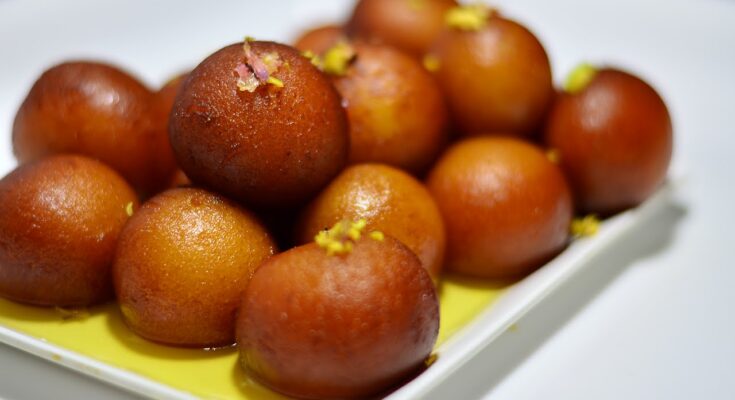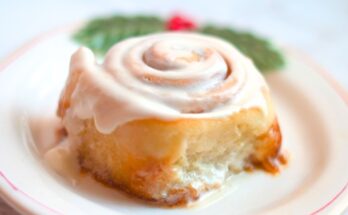Gulab Jamun Recipe: Imagine a soft, warm, spongy ball soaked in a fragrant sugar syrup that melts in your mouth with every bite. That’s Gulab Jamun for you—one of the most beloved desserts across India and South Asia. Often referred to as the “Indian donut,” Gulab Jamun is a milk-solid-based sweet, traditionally made using khoya (reduced milk) or milk powder. The dessert gets its name from two words: “Gulab,” meaning rose, referring to the rose-scented syrup, and “Jamun,” a fruit similar in shape and color to the dessert.
These delicious sweet balls are fried till golden brown and soaked in a warm sugar syrup infused with cardamom, rose water, or saffron. Whether it’s a wedding, a religious ceremony, or a casual festive gathering, Gulab Jamun always finds its way to the dessert table. It’s more than just a treat—it’s a nostalgic trip to childhood memories for many.
Origin and Cultural Significance
Gulab Jamun has a rich history. It’s believed to have originated in the medieval Indian era and was inspired by Persian and Turkish desserts. The Mughals brought it to India, and over time, it was adapted to suit local tastes. Some even say that Gulab Jamun is an accidental invention by a royal chef.
Culturally, Gulab Jamun is a symbol of celebration. Be it Diwali, Eid, Holi, or Raksha Bandhan, this sweet dish is a staple. In fact, many Indian households consider it mandatory to prepare Gulab Jamun during major festivals. It is also served in temples as a prasad (offering) and is a staple in wedding menus.
In short, Gulab Jamun is not just food—it’s an emotion that binds generations.
Ingredients Required
For the Dough
To make soft and melt-in-the-mouth Gulab Jamun, the dough is critical. Here’s what you’ll need:
- 1 cup milk powder (unsweetened)
- 1/4 cup all-purpose flour (maida)
- 2 tablespoons semolina (rava/sooji)
- 1/4 teaspoon baking soda
- 2 tablespoons ghee or unsalted butter (softened)
- 1/4 cup milk (warm, add gradually)
- 1 teaspoon lemon juice or yogurt (optional, for added softness)
These ingredients combine to create a soft, pliable dough. The balance between dry and wet ingredients is essential to achieve the perfect texture that’s neither too sticky nor too crumbly.
For the Sugar Syrup
The syrup is what makes Gulab Jamun incredibly luscious and flavorful. Here’s what you’ll need:
- 2 cups sugar
- 1.5 cups water
- 4-5 green cardamom pods (slightly crushed)
- 1 tablespoon rose water (optional)
- Few strands of saffron (optional for aroma and color)
- 1 teaspoon lemon juice (to prevent crystallization)
The syrup should be warm—not boiling—when you soak the fried Gulab Jamun. This allows the balls to absorb the syrup properly without becoming too soggy or collapsing.
Optional Flavor Enhancers
To elevate the flavor, consider these additions:
- Rose water or kewra water: Adds floral notes
- Saffron strands: Imparts a rich color and luxurious aroma
- Pistachio or almond slivers: For garnish and crunch
Adding these ingredients isn’t mandatory, but they definitely take the dish to gourmet levels. Plus, they add a visual appeal that makes your dessert Instagram-worthy!
Kitchen Tools You’ll Need
While Gulab Jamun isn’t particularly fussy in terms of equipment, having the right tools can make the process smoother:
- Mixing bowls
- Measuring cups and spoons
- Deep frying pan or kadai
- Slotted spoon
- Saucepan for syrup
- Paper towels (for draining)
- Plate or tray for resting the balls
Good quality utensils ensure consistency and safety—especially when handling hot syrup and oil. It’s best to use a heavy-bottomed pan to maintain even temperature while frying.
Preparing the Sugar Syrup
Step-by-Step Syrup Preparation
- Combine sugar and water in a saucepan over medium heat. Stir until the sugar dissolves completely.
- Add crushed cardamom pods and saffron strands. Let the mixture come to a boil.
- Once boiling, reduce the heat and let it simmer for 8-10 minutes.
- Add rose water or kewra essence for flavor and turn off the heat.
- Mix in lemon juice to prevent the syrup from crystallizing as it cools.
The syrup should be of single-thread consistency—sticky but not too thick. If the syrup is too dense, the Gulab Jamun won’t absorb it well. If it’s too thin, it won’t impart enough flavor.
Tips to Get the Syrup Right
- Don’t over-boil. Thick syrup can ruin the texture of Gulab Jamun.
- Always prepare syrup before frying so it’s warm and ready.
- Test syrup consistency with your fingers: take a drop between your thumb and forefinger; you should feel a slight stickiness.
- Lemon juice is crucial—it acts as an anti-crystallizing agent.
Getting the syrup right is half the battle won. Remember, the syrup is not just sugar water; it’s the soul of this dessert.
Making the Gulab Jamun Dough
Kneading Tips for Perfect Texture
- In a large bowl, mix milk powder, all-purpose flour, semolina, baking soda, and ghee.
- Gradually add warm milk, a spoon at a time. Stir and knead gently until you form a soft, slightly sticky dough.
- Avoid over-kneading, which can make the balls tough.
- Let the dough rest for at least 10-15 minutes. This allows the semolina to absorb moisture and soften.
You want the dough to be soft but not sticky. If it’s too dry, add a bit more milk. Too wet? Sprinkle a little flour. Kneading gently is key—think of it like handling a baby’s cheeks. Soft, careful, and no rough movements!
Resting the Dough
Letting the dough rest is essential. This resting period allows the gluten to relax, which leads to smoother balls. It also ensures that the ingredients bind well together. Cover the dough with a damp cloth to prevent it from drying out.
Shaping and Frying the Balls
How to Shape Evenly
Now comes the fun part—shaping the dough into neat little balls. This step is more crucial than it looks.
- After resting, divide the dough into small portions about the size of a marble.
- Grease your palms slightly and roll each portion gently until it’s smooth with no cracks. Cracks can cause the Gulab Jamuns to break while frying.
- Aim for uniform size so that all the balls cook evenly.
- If you find cracks forming, wet your fingers slightly and roll again to smoothen the surface.
The goal is to make each ball so smooth and round that it resembles a pearl. Avoid applying too much pressure, and don’t rush this step. Think of yourself as an artist crafting edible jewels!
Frying to Golden Perfection
This step can make or break your Gulab Jamun—literally. Here’s how to do it right:
- Heat ghee or oil in a deep frying pan over low to medium heat. Do not let it get too hot.
- To test the oil, drop a small piece of dough in—if it rises slowly without changing color instantly, it’s ready.
- Gently drop in 4–5 balls at a time. Overcrowding the pan can lower the oil temperature.
- Stir gently and continuously to ensure even cooking on all sides.
- Fry until the balls turn a uniform golden brown, not dark brown. This should take about 6–8 minutes.
- Remove the fried balls and drain on paper towels for a minute before soaking.
A common mistake is frying on high heat, which browns the outside quickly but leaves the inside raw. Low and slow is the secret here. Let the color be your guide—golden brown means success!
Soaking in Sugar Syrup
Soak Time and Technique
Once your golden beauties are ready, it’s time for them to take a warm bath in the sugar syrup:
- Make sure the syrup is warm but not boiling.
- Gently add the fried Gulab Jamuns into the syrup.
- Let them soak for at least 2–3 hours to absorb the sweetness and flavor fully.
- The balls will almost double in size as they soak—don’t worry, that’s a good thing!
Avoid stirring them too much while soaking, as they are very delicate when hot. Use a light hand if you need to move them around. You can also reheat the syrup slightly to encourage faster absorption, but never boil.
Serving Suggestions
Gulab Jamun can be served:
- Warm: Soft and gooey, perfect for cold weather.
- Chilled: Firm and chewy, great for hot days.
- With Ice Cream: A modern twist that’s incredibly popular in fusion desserts.
- Garnished: Top with chopped pistachios, almonds, or even edible silver leaf for an elegant touch.
The best part? You can even make them in advance. They stay good in the fridge for up to a week!
Common Mistakes to Avoid
Even seasoned cooks mess up Gulab Jamun. Here are the biggest blunders to watch out for:
- Too much baking soda: This can cause the balls to break in oil.
- Dry dough: Makes the balls crack and absorb too much oil.
- High frying temperature: Leads to uncooked centers.
- Thick syrup: Prevents proper absorption.
- Not resting the dough: Results in hard, chewy balls.
Keep this checklist handy, and you’ll sidestep the most common disasters.
Variations of Gulab Jamun
Khoya Gulab Jamun
This traditional method uses mawa or khoya instead of milk powder. It has a richer texture and more authentic flavor, though it requires more time and effort.
Bread Gulab Jamun
Perfect for a quick fix, this version uses white bread slices soaked in milk and shaped into balls. It’s not traditional, but it’s a great beginner-friendly option.
Sweet Potato Gulab Jamun
A healthier alternative, these use mashed sweet potato in the dough. Slightly denser, but still delicious and unique!
Stuffed Gulab Jamun
Take your dessert game up a notch by stuffing the balls with dry fruits or even chocolate chips. Imagine biting into a Gulab Jamun and finding a nutty or gooey surprise inside!
Healthier Alternatives and Tips
Baking Instead of Frying
Looking to enjoy Gulab Jamun without the guilt? Try baking them!
- Preheat your oven to 350°F (175°C).
- Place shaped balls on a greased baking tray.
- Lightly brush with ghee or butter.
- Bake for about 20–25 minutes or until golden brown, flipping halfway through.
While the texture won’t be as rich and crispy as deep-fried ones, they’re still incredibly satisfying. Once baked, soak them in warm syrup just like you would with fried ones.
Using Less Sugar
You can reduce sugar without sacrificing taste by:
- Using natural sweeteners like jaggery syrup or honey (though this alters the traditional flavor).
- Cutting the sugar in the syrup by 25% and infusing it with more spices (cardamom, saffron) and rose water to maintain the depth of flavor.
This is a great trick for people managing diabetes or looking to reduce calorie intake.
Dairy-Free or Vegan Options
For a plant-based version:
- Replace milk powder with coconut milk powder or soy milk powder.
- Use almond milk in place of dairy milk.
- Fry in oil or vegan butter instead of ghee.
The result might be slightly different in texture but still indulgent and flavorful. This makes Gulab Jamun accessible to more dietary needs!
Storing and Reheating Tips
How to Store
Gulab Jamun stores quite well if done properly:
- Room Temperature: Keep in an airtight container for up to 2 days.
- Refrigerator: Store with syrup in a sealed container for up to a week.
- Freezer: For longer storage, freeze without syrup. Thaw and soak in warm syrup when needed.
Avoid storing them without syrup at room temperature as they can dry out quickly.
How to Reheat
Reheating helps revive the soft texture:
- Microwave: Heat for 30–40 seconds. Make sure they’re soaked.
- Stovetop: Warm them gently in a saucepan with some syrup.
Pro tip: Never reheat them dry. Always reheat with syrup to keep them juicy and flavorful.
Pairings and Presentation Ideas
Perfect Pairings
Pair Gulab Jamun with:
- Vanilla ice cream: A creamy contrast to the syrupy warmth.
- Chilled rabri: Rich, condensed milk creates a luscious combination.
- Coffee or masala chai: A spiced beverage cuts through the sweetness.
Presentation Tips
Presentation matters, especially when serving guests or making it festive:
- Serve in small glass bowls for a classy touch.
- Top with silver leaf (varq) and chopped nuts.
- Add a touch of saffron syrup drizzle before serving.
It’s these little touches that elevate your homemade dessert into a five-star dish!
Cultural and Festive Significance
Popular Festivals for Gulab Jamun
Gulab Jamun is a star at every major Indian celebration:
- Diwali: A staple in sweet platters.
- Eid: Served post-meal for a sweet ending.
- Raksha Bandhan & Holi: Symbolizes the joy and bonding of family and friends.
- Weddings & Anniversaries: Almost always present in the dessert spread.
It’s more than a sweet—Gulab Jamun is a part of the cultural fabric, a symbol of celebration, love, and tradition.
Global Popularity
Gulab Jamun has crossed borders. You’ll find it in:
- Indian restaurants abroad
- Fusion desserts like Gulab Jamun cheesecakes and sundaes
- Cooking shows and recipe blogs worldwide
This sweet dish is gaining international fame for all the right reasons. It represents Indian heritage in the most delicious way.
FAQs about Gulab Jamun Recipe
Q1. Why does my Gulab Jamun break while frying?
This usually happens when the dough is too soft or has excess moisture. To fix this, knead the dough gently and ensure it’s smooth but firm. Avoid overmixing as well.
Q2. Why are my Gulab Jamuns hard inside?
Hard centers result from overcooked balls or using too much flour. Make sure the oil is on medium-low heat and the dough is moist and well-kneaded.
Q3. Can I make Gulab Jamun without khoya or milk powder?
Yes, but texture and flavor may vary. You can use paneer, bread, or even semolina (sooji) as an alternative, though traditional recipes use khoya or milk powder for richness.
Q4. How long should I soak Gulab Jamuns in sugar syrup?
Soak the fried balls in warm sugar syrup for at least 1–2 hours for the best flavor and juiciness. Some prefer overnight soaking for maximum sweetness.
Q5. Can I store Gulab Jamun?
Absolutely! Store in an airtight container in the refrigerator for up to a week. Reheat slightly before serving to restore softness.
Q6. Is it better to use ghee or oil for frying Gulab Jamun?
Traditional recipes use ghee for a richer taste, but you can also use neutral oil. Ensure the oil isn’t too hot to prevent uneven cooking.
Q7. Can Gulab Jamun be made vegan?
Yes, use plant-based milk powder, dairy-free yogurt, and coconut milk in the syrup. The taste may vary slightly but will still be delicious.
Q8. Why do my Gulab Jamuns not absorb the syrup?
This could be due to a cold syrup or over-fried balls. Always use warm syrup and make sure the balls are not too crusty to allow absorption.
Q9. What’s the ideal size for Gulab Jamun before frying?
Keep them small—about the size of a marble—as they expand while frying and soaking. Large balls may remain uncooked inside.
Q10. Can I add flavors to the sugar syrup?
Definitely! Cardamom, rose water, saffron, or even a hint of lemon juice enhances the syrup and adds authentic Indian dessert flavor.
Conclusion
Gulab Jamun is not just a dessert—it’s an experience. From kneading the soft dough to soaking the golden balls in syrup, every step brings you closer to a timeless treat. It’s simple, satisfying, and steeped in cultural richness. Whether you follow the traditional method or put a modern spin on it, there’s no wrong way to make Gulab Jamun—just make it with love. So roll up your sleeves and get ready to create magic in your kitchen!



